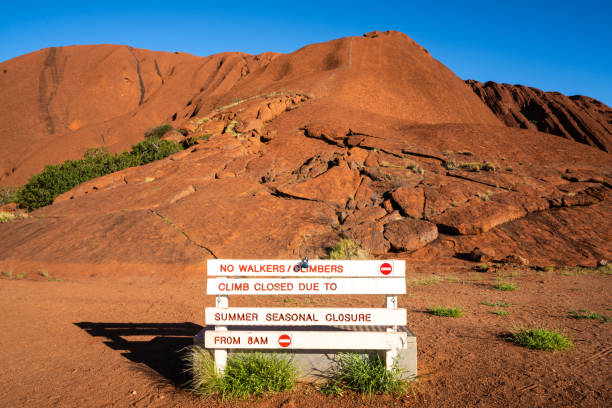Uluru, also known as Ayers Rock, stands as an iconic monolith in the heart of Australia’s Red Centre, holding deep spiritual significance for the Anangu – the area’s traditional custodians. A mesmerizing sight, it draws inquisitive travelers from around the globe, eager to behold its grandeur. On average, Uluru beckons over 300,000 visitors each year, making it one of Australia’s top tourist attractions. This article delves into the details of these visitor numbers, exploring the seasonal trends, cultural importance, and the beautiful, sustainable travel experiences that Uluru offers.
The Magnitude of Uluru’s Visitor Numbers Annually

Uluru’s magnetic appeal ensures a steady influx of travelers annually. In recent years, numbers have fluctuated, with the latest tourist data reflecting a significant engagement with this natural wonder. These statistics not only highlight the rock’s popularity but also underscore the importance of managing this influx with care to minimize the impact on the sacred site.
Annual Visitor Count:
| Year | Visitor Numbers |
|---|---|
| 2018 | 300,000+ |
| 2019 | 400,000+ |
| 2020 | Data affected by travel restrictions |
What Draws a Multitude to Uluru Every Year?
The allure of Uluru can be attributed to several compelling factors. Firstly, its cultural resonance with the Anangu people invites those seeking a deeper understanding of indigenous histories and beliefs. The rock formations and surrounding desert landscape offer a glimpse into Australia’s ancient geology, while the spectacular color changes of Uluru at sunrise and sunset provide a truly unforgettable natural phenomenon. Furthermore, the prospects of a comprehensive ‘Uluru 3 day tour’ have become a bucket-list experience for many adventure enthusiasts.
- The sacred significance and storytelling of the Anangu people
- Geological uniqueness and the beauty of desert landscapes
- The transformative hues of sunrise and sunset over Uluru
Yearly Trends and Seasonal Variations in Visitation
Visitor numbers to Uluru vary with the seasons. The cooler months from May to September typically attract the highest number of tourists, while the scorching heat of the summer can see a dip in arrivals. Major events and school holidays also influence the flow of tourists, as families and individuals aim to sync their travel plans with such occasions for an optimal experience.
Peak Season Visitor Advantages:
- Milder weather for exploration
- Increased number of guided tours and cultural activities
- Coordination with regional events and festivities
Sustainability and Visitor Management at Uluru
The challenge of balancing tourist interest with the conservation of Uluru’s fragile environment and cultural heritage is ongoing. Responsible travel initiatives and stringent visitor guidelines have been put in place to safeguard the site. The recent ban on climbing Uluru, a pivotal step towards respecting indigenous wishes, has been instrumental in redirecting tourists towards more sustainable activities such as walking tours and cultural centers while simultaneously reducing environmental wear.
Future Projections for Uluru Tourism
Looking ahead, Uluru is set to remain an emblematic destination while adapting to global tourism trends. The indigenous community and park management are working towards a sustainable future, where digital and virtual experiences may complement physical visits. The ‘Uluru 3 day tour’ package continues to be a popular option, suggesting a steady interest in immersive experiences at the site.
Beyond the Rock: Additional Attractions Around Uluru
While Uluru itself is a magnet for visitors, the surrounding region is speckled with myriad attractions that enrich the travel experience. From the towering domes of Kata Tjuta to the serenity of the Valley of the Winds, the Uluru-Kata Tjuta National Park is a trove of natural beauty. These additional sites offer diverse landscapes and opportunities for wildlife encounters, thus extending the visitor’s connection with the Australian outback.
Planning Your Visit to the Iconic Uluru
Those intending to visit Uluru should plan responsibly. Consider engaging with local guides who provide insight into the rich cultural tapestry of the area, and always respect the landscape by adhering to all park rules and guidelines. The ‘Uluru 3 day tour’ is an excellent way to ensure a full and respectful itinerary, designed to leave minimal environmental footprint while maximizing the visitor experience.
Conclusion
Uluru’s status as a world-renowned tourist destination is undeniable, attracting a vast audience keen to explore its cultural and natural wonders. Efforts to balance visitor enjoyment with the preservation of this sacred site are paramount and have led to innovative approaches in tourism management. As visitors continue to flock to Uluru each year, it is the collective responsibility of all to ensure that this majestic site remains unspoiled for generations to come.
Frequently Asked Questions
Q: What is the best time of year to visit Uluru?
A: The preferred time to visit is during the cooler months from May to September, when the climate is mild and conditions are more favorable for outdoor activities.
Q: How has the ban on climbing Uluru affected visitor numbers?
A: The ban initially impacted numbers due to the cessation of climb-related tours. However, it has since led to an increased focus on cultural experiences and other attractions within the park.
Q: Are there still ways to engage with the Anangu culture while visiting Uluru?
A: Yes, visitors can participate in guided walks, cultural centers, and art galleries, which offer engagement with the Anangu culture.
Q: What facilities are available for tourists in Uluru-Kata Tjuta National Park?
A: The park provides various facilities including accommodations, dining options, informative visitor centers, and well-maintained walking trails.
Q: How can I contribute to the conservation of Uluru during my visit?
A: You can respect the site by following park rules, staying on designated paths, taking all litter with you, and supporting local businesses that practice sustainable tourism.
